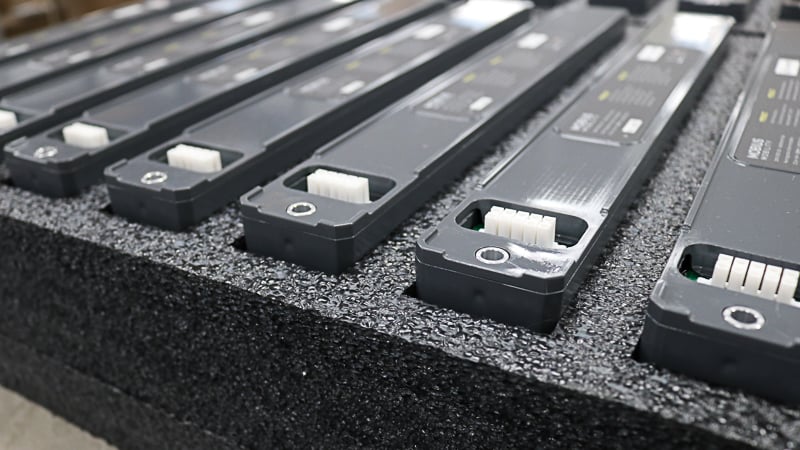When power applications and equipment with custom battery packs, it's ideal to place batteries in storage when not in use for extended periods of time. This practice will prevent batteries from becoming overcharged in equipment and degrading.
Specific battery chemistries will require special storage considerations to reduce the discharge rate of batteries and ensure that optimal charge capacity is maintained. Understanding these factors will allow you to select the right battery chemistry for applications while adopting the best storage and charge management strategies to avoid permanent battery damage.
Common Storage Issues
Numerous problems can occur to batteries based on how they will be stored and the length of time before the battery will be put back into the application. The room temperature and other environmental factors can impact the charge of the battery, which can lengthen or shorten the battery's life cycle. Extremely hot temperatures will degrade the chemistries of the battery, causing it to have a shorter battery life or permanent capacity loss. On the other hand, excessive cold temperatures below 0 degrees Celsius can cause the aqueous electrolyte fluid inside the batteries to freeze.

Battery packs can be shipped and stored in custom ESD foam packaging for ideal management conditions.
Other storage issues involve the state-of-charge percentage for specific batteries. Some batteries can be discharged fully before being placed into storage. However, other batteries, such as lead acid, must retain a full charge before going into storage for long periods of time.
The reasons that batteries must have different states of charge is because age-related capacity loss can occur. Batteries that contain lithium and nickel-based chemistries must have a state-of-charge of 40 percent to allow for self-discharge so that the voltage doesn't dip below 2 volts per cell. If the discharge does go below this percentage, the cells can become unstable, overheat, or be more susceptible to mechanical stresses.
Ideal Battery Storage Based on Chemistry
For both primary and rechargeable batteries, they should be stored in an area that doesn't experience significant temperature fluctuations. They should be completely removed from the equipment or application and placed in a cool and dry location that has an indoor room temperature from 0 degrees Celsius up to 20 degrees Celsius. You should avoid placing batteries into freezers, although they may be stored in a refrigerated state.
To prevent electrolyte loss, a vapor-proof packing can be used. Here are specific storage best practices for specific battery chemistries:
Lithium-Ion
Lithium-ion batteries can be fully discharged before being placed into storage. Yet, they should have a charge rate of roughly 40 percent. As mentioned earlier, lithium-ion should never have its cell voltage drop below 2 volts per cell and should not have a maximum voltage of 4.1 volts. So, this battery will need to have the voltage topped off occasionally during long periods of storage to prevent over-discharge. Lithium-ion batteries can be stored up to 10 years without having its capacity significantly impacted.

Lithium batteries should be maintained in climatically controlled warehousing for optimum storage, and battery performance.
The moment that batteries with lithium-ion chemistries are placed into storage, they will experience a discharge rate of 5 percent within the first 24 hours at normal room temperatures. Then it will go through a self-discharge rate of 1 to 2 percent every month. After being stored for a year, lithium-ion batteries can recover 98% to 96% of its capacity when kept at temperatures of 0-25 degrees Celsius, respectively, if the battery is at 40% charge rate. If the battery is kept at a 100% charge rate, it will have a recovered capacity of 94% to 80% at the same temperatures after 3 months.
Nickel-Based Chemistries
For batteries with nickel-based chemistries, such as nickel cadmium and nickel metal hydride, they can be stored in a discharged state or a charged state. If they are stored with a charge, both batteries will experience a very high self-discharge rage of 10-15% during the first 24 hours. Then, the batteries will self-discharge at a rate of 10-15% every month they are in storage. They should be kept at room temperatures of 0 degrees up to 25 degrees Celsius. Sometime during storage, nickel metal hydride will need to be charged before use.
No matter what charge is kept, nickel-based batteries will have a recoverable capacity of 97% to 99% when kept at low room temperatures for up to a year. In addition, some of the lost capacity can be regained through priming the batteries. These batteries can be left in storage from 3 to 5 years.
Lead Acid Chemistries
Batteries with lead acid chemistries must be stored at a fully charged state. If not, sulfation occurs as lead sulfate crystals will form along the electrodes the longer the battery is in storage. Like all batteries, lead acid chemistries are best stored at ideal cool temperatures of 0 to 25 degrees Celsius. The higher the temperature, the less recoverable capacity will be available for lead acid batteries.
The recoverable capacity of lead acid batteries is roughly 97% at 0 degrees Celsius temperatures after 6 months, as the capacity rate will decrease up to 90% when reaching 25-degree Celsius temperatures. Every month, the batteries will experience a 5% discharge rate. A sealed lead acid battery can have a shelf life of up to 2 years.
State-of-charge rates for lead acid batteries can vary between manufacturers, and each manufacturer has different guidelines on when to recharge the batteries. Some manufacturers will say that the battery should be charged when reaching 70 percent, while other companies state that you should wait until the state-of-charge rate falls to 60 percent. The amount of present sulfation can prevent lead acid batteries from being charged. An elevated voltage can help reactivate the battery so long as the power supply that is used to recharge the battery has a current limiting function and the current limit is set to a low level.
Managing Your Battery Charge and Storage
Before obtaining custom battery packs for your applications, you should take into consideration the environment and the use of the batteries. No matter the type of chemistry, batteries that experience significant usage and mechanical stresses may experience failure when later placed into storage. In addition, poor fabrication and handling can also increase the self-discharge rate of batteries as well as create significant capacity loss that will differ from stated best practices.
If you will be storing batteries for long periods of time, such as over 6 months, then you should develop battery charge management practices to prevent battery deterioration and capacity loss. The cell voltage should be periodically checked as the cells should be charged based on the manufacturer’s guidelines. In addition, room temperatures and vibrations should also be noted to maintain the ideal cool environment with little disturbance. Then you will be able to successfully prolong the life of your battery and place it in use for your applications without running out of power.
Summary
As we have identified, every chemistry is a little different regarding charging, storage practices, recommended state of charge rates for storage, and self-discharge rates. You should always refer to the manufacturing specs for the specific battery you are managing to follow recommended practices for the most optimal shelf life and overall performance.
Key Takeaways
- Storage practices vary by cell chemistry - lithium-ion requires ~40% charge, nickel-based can be stored charged or discharged, and lead acid must always be fully charged.
- Temperature control is critical, with all chemistries performing best between 0°C and 25°C to prevent accelerated degradation or freezing.
- Lithium-ion batteries have low self-discharge, but periodic voltage checks are needed to prevent cells from dropping below 2 volts.
- Nickel-based batteries experience high self-discharge, but recoverable capacity can be regained through priming after storage.
- Lead acid batteries are highly sensitive to undercharging, as sulfation can permanently reduce capacity if not kept at full charge.
















